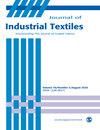Influence of pre-tensioning high-performance yarns on the bending stiffness of textile composites
IF 2
4区 工程技术
Q1 MATERIALS SCIENCE, TEXTILES
引用次数: 0
Abstract
This study explores the stiffness enhancement in textile composites using four different fiber types: carbon, Kevlar, Vectran, and high-tenacity polyester (HTP). Pretension levels of 0.2, 2, 5, and 10 N were applied. A setup was developed to measure fiber stiffness. Results indicate that carbon fiber consistently demonstrates the highest stiffness across all pretenstionlevels, attributable to its high tensile strength and modulus. Kevlar fiber, although initially less stiff than carbon, exhibits the most substantial increase in stiffness, particularly between 5 and 10 N of pretension, reaching a peak stiffness of 33.8 at 10 N. Vectran fiber shows a gradual increase in stiffness, surpassing HTP but slightly lagging behind carbon and Kevlar. The rates of yarn-specific bending stiffness increase were measured as 0.168 for HTP, 0.054 for carbon fiber, 0.173 for Kevlar fiber, and 0.191 for Vectran fiber. The study highlights the importance of understanding how yarn pretension affects the bending stiffness of yarn-polymer composites, which is crucial for advancements in textile engineering. It was found that variations in the bending stiffness of HTP and carbon fibers significantly impacted the composite bending stiffness more than Vectran and Kevlar fibers under pretension during composite formation. High-stiffness yarns were less influenced by increasing pretension during composite fabrication. The study suggests utilizing yarn pretension to control the stiffness of textile/polymer composites and proposes individually tensioning and pultruding fibers or yarns in the polymer matrix before composite formation. A specialized setup for achieving this during the protrusion process is recommended.预拉伸高性能纱线对纺织复合材料弯曲刚度的影响
本研究探讨了使用四种不同纤维类型(碳纤维、凯芙拉纤维、Vectran 纤维和高强聚酯纤维 (HTP))的纺织复合材料的刚度增强问题。施加的预拉力水平分别为 0.2、2、5 和 10 N。开发了一套测量纤维刚度的装置。结果表明,在所有预拉伸水平下,碳纤维始终表现出最高的刚度,这归功于其较高的拉伸强度和模量。Vectran 纤维的刚度逐渐增加,超过了 HTP,但略微落后于碳纤维和 Kevlar 纤维。根据测量,HTP 的纱线特定弯曲刚度增加率为 0.168,碳纤维为 0.054,Kevlar 纤维为 0.173,Vectran 纤维为 0.191。这项研究强调了了解纱线预拉伸如何影响纱线-聚合物复合材料弯曲刚度的重要性,这对纺织工程的发展至关重要。研究发现,与 Vectran 和 Kevlar 纤维相比,HTP 和碳纤维的弯曲刚度变化对复合材料弯曲刚度的影响更大。在复合材料制造过程中,高刚度纱线受预紧力增加的影响较小。该研究建议利用纱线预拉伸来控制纺织品/聚合物复合材料的刚度,并建议在复合材料成型前在聚合物基体中单独拉伸和拉挤纤维或纱线。建议在拉伸过程中采用专门的装置来实现这一目的。
本文章由计算机程序翻译,如有差异,请以英文原文为准。
求助全文
约1分钟内获得全文
求助全文
来源期刊

Journal of Industrial Textiles
MATERIALS SCIENCE, TEXTILES-
CiteScore
5.30
自引率
18.80%
发文量
165
审稿时长
2.3 months
期刊介绍:
The Journal of Industrial Textiles is the only peer reviewed journal devoted exclusively to technology, processing, methodology, modelling and applications in technical textiles, nonwovens, coated and laminated fabrics, textile composites and nanofibers.
 求助内容:
求助内容: 应助结果提醒方式:
应助结果提醒方式:


